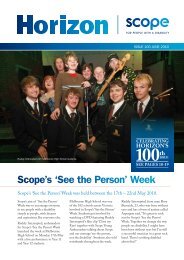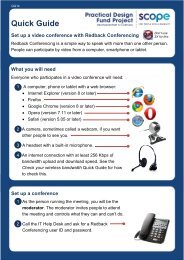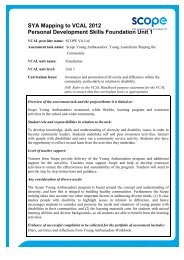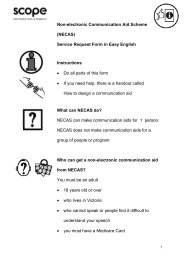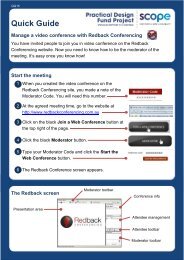Positive behaviour support Getting it right from the start
Positive behaviour support Getting it right from the start
Positive behaviour support Getting it right from the start
You also want an ePaper? Increase the reach of your titles
YUMPU automatically turns print PDFs into web optimized ePapers that Google loves.
<strong>Pos<strong>it</strong>ive</strong> <strong>behaviour</strong> <strong>support</strong>: <strong>Getting</strong> <strong>it</strong> <strong>right</strong> <strong>from</strong> <strong>the</strong> <strong>start</strong> - Facil<strong>it</strong>ators reference manual 37<br />
5. O<strong>the</strong>r senses such as smell should be used to interact w<strong>it</strong>h <strong>the</strong> person and provide <strong>the</strong>m<br />
w<strong>it</strong>h information about <strong>the</strong>ir environment.<br />
6. Always provide verbal warnings (where needed) in conjunction w<strong>it</strong>h object symbols, raised<br />
symbols or touch cues, to warn <strong>the</strong> person about what is going to happen next.<br />
7. Always talk to <strong>the</strong> person and tell <strong>the</strong>m what you are doing and what is happening.<br />
8. Be explic<strong>it</strong> in giving verbal directions to a blind person. Pointing or saying ‘over <strong>the</strong>re’ is of<br />
no help.<br />
9. If you notice a visually impaired person heading for danger, give <strong>the</strong> immediate short command<br />
to STOP. (Do not say ’watch out’, as <strong>the</strong>y won’t know whe<strong>the</strong>r to stop, duck or back up.) Then<br />
explain <strong>the</strong> danger.<br />
10. If <strong>the</strong> person has trouble processing and understanding speech, use a range of tactile cues<br />
to assist <strong>the</strong> person. For example, if something is unique to you (such as a bracelet that you<br />
wear) introduce yourself and direct <strong>the</strong> person’s hand to your bracelet.<br />
PowerPoint 57*<br />
General strategies to reduce sensory overload (including tactile defensiveness)<br />
1. Use a quiet calm voice.<br />
2. Set aside an uncluttered room where people can relax.<br />
3. Engage people in an activ<strong>it</strong>y that calms <strong>the</strong>m (you may need a sensory assessment to<br />
find this out).<br />
4. Be aware that some people have <strong>the</strong>ir own calming techniques and are not trying to be<br />
difficult, e.g. s<strong>it</strong>ting on <strong>the</strong> floor ra<strong>the</strong>r than climbing <strong>the</strong> stairs, taking empty packages<br />
out of <strong>the</strong> rubbish bin as <strong>the</strong>y need something to scrunch to calm <strong>the</strong>mselves<br />
5. Inform people when something that disturbs <strong>the</strong>m is going to happen, e.g. bus arriving<br />
home, noise <strong>from</strong> maintain work, you are going to touch <strong>the</strong>ir hands to cut <strong>the</strong>ir nails.<br />
6. Help people to feel in control and if possible facil<strong>it</strong>ate people to do thing for <strong>the</strong>mselves<br />
7. Reduce noise levels in <strong>the</strong> room<br />
8. Reduce visual clutter, e.g. check to see that <strong>the</strong>re are not too many pictures on <strong>the</strong> wall<br />
9. Use a firm touch ra<strong>the</strong>r than a light touch<br />
For <strong>the</strong> person you have been developing a profile on discuss <strong>the</strong> following areas and how<br />
<strong>the</strong>y may impact on <strong>the</strong>ir daily routines and identify su<strong>it</strong>able strategies to use.<br />
• Hearing levels or abil<strong>it</strong>y<br />
• Visual abil<strong>it</strong>y<br />
• Tactile defensiveness issues<br />
Add this summary information to your client profile.



